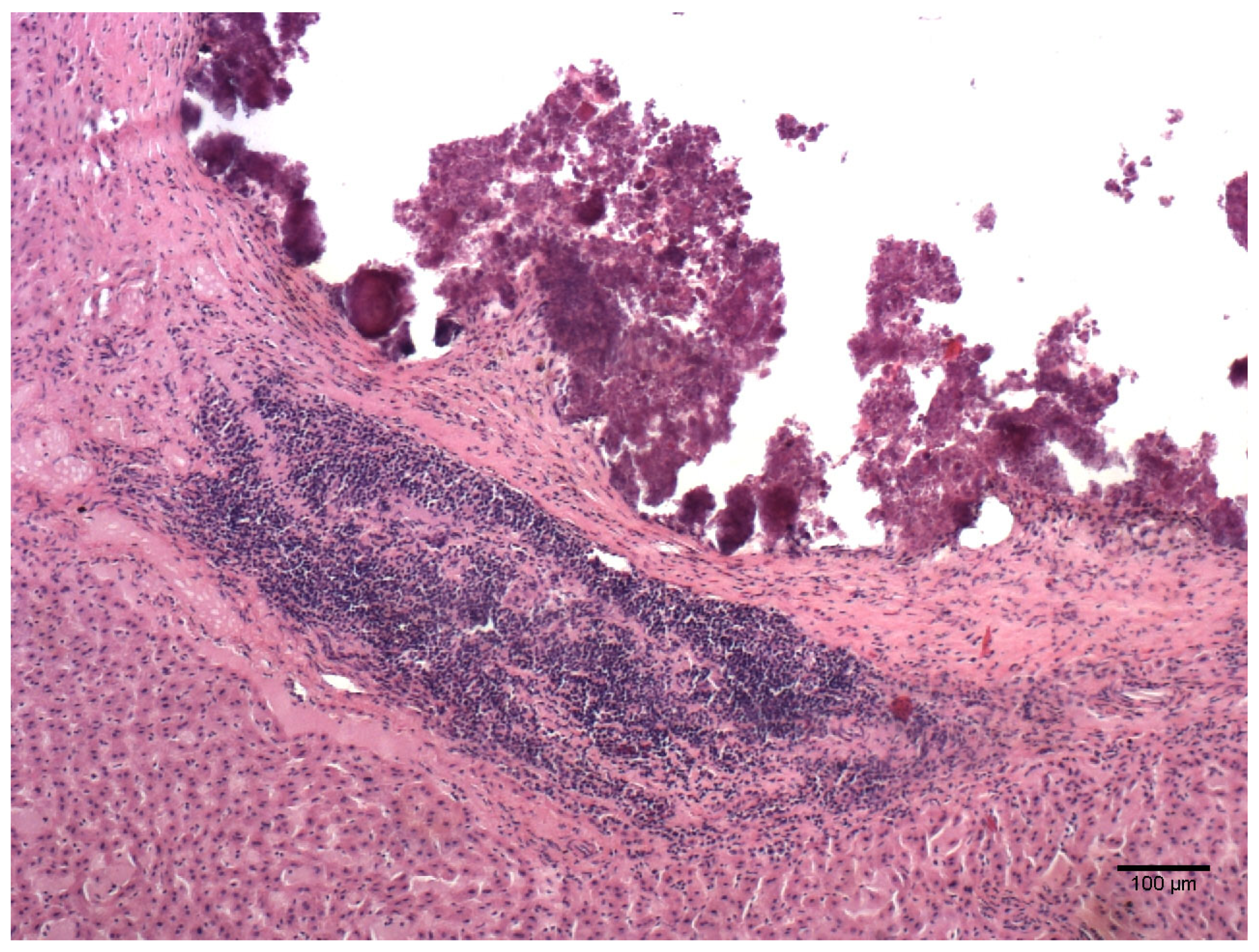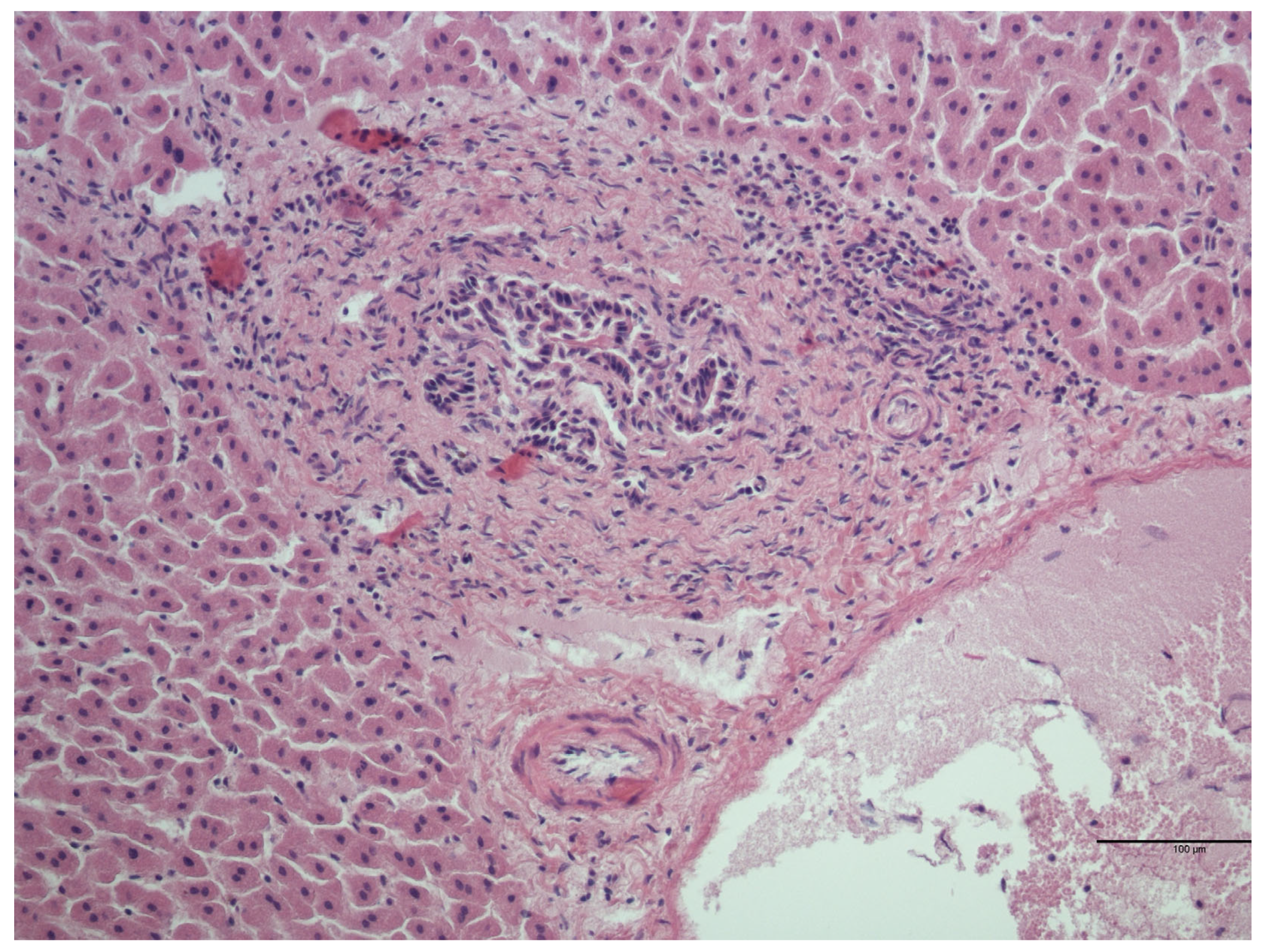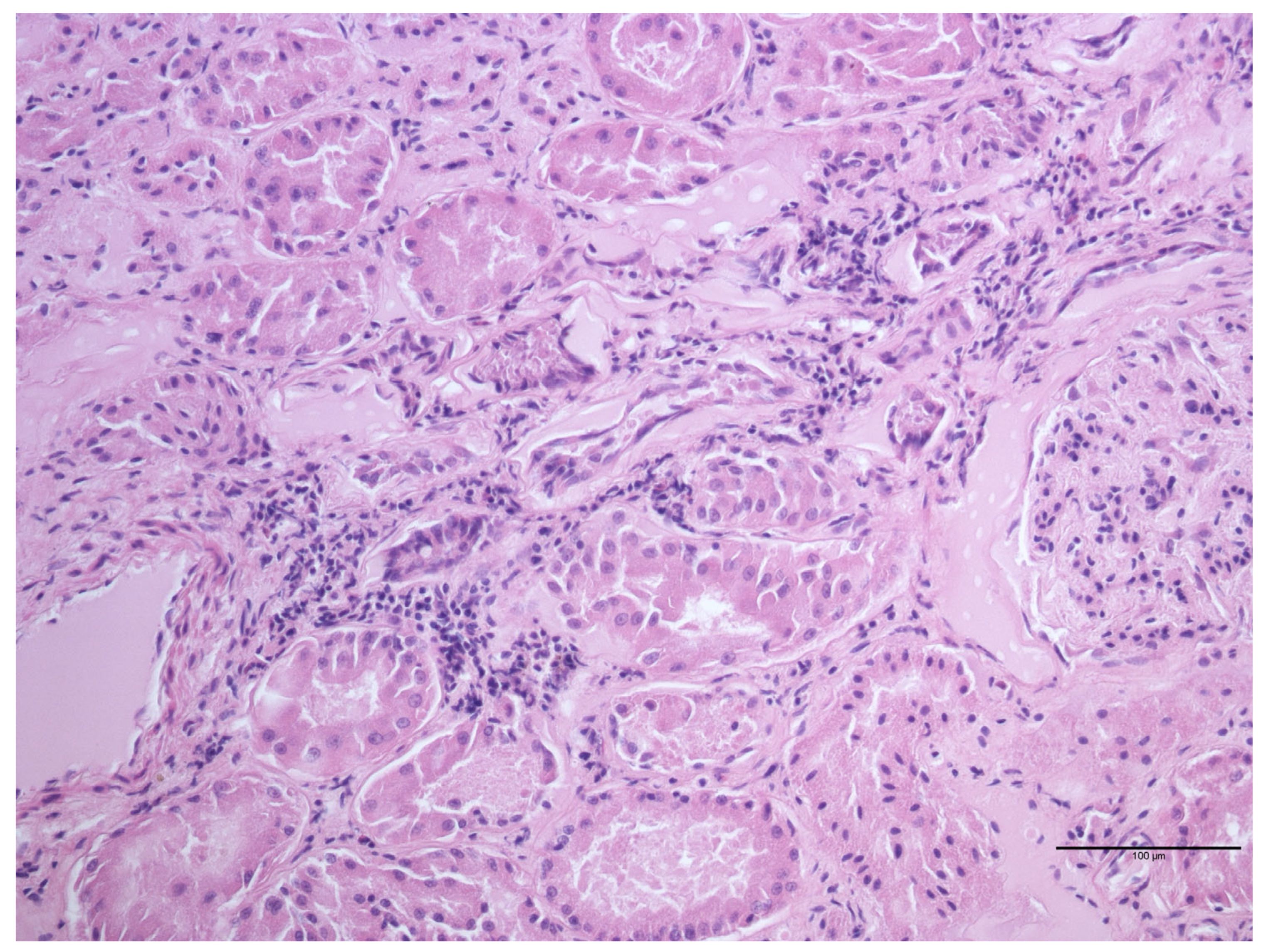A Health Status Update of Myocastor coypus in Northern Italy
Abstract
Simple Summary
Abstract
1. Introduction
2. Materials and Methods
2.1. Animals and Samples Collection
2.2. Age Estimation
2.3. Histological Analysis
2.4. Virological Analysis
2.5. Bacteriological Analysis
2.6. Parasitological Analysis
2.7. Statistical Analysis
3. Results
3.1. Age Estimation
3.2. Histological Analysis
3.3. Bacteriological, Virological and Parasitological Analyses
None of the Samples Tested Positive for HEV or EMCV
4. Discussion
5. Conclusions
Author Contributions
Funding
Institutional Review Board Statement
Informed Consent Statement
Data Availability Statement
Conflicts of Interest
References
- Carter, J.; Leonard, B.P. A Review of the Literature on the Worldwide Distribution, Spread of, and Efforts to Eradicate the Coypu (Myocastor Coypus). Wildl. Soc. Bull. 2002, 30, 162–175. [Google Scholar]
- Pedruzzi, L.; Schertler, A.; Giuntini, S.; Leggiero, I.; Mori, E. An Update on the Distribution of the Coypu, Myocastor Coypus, in Asia and Africa through Published Literature, Citizen-Science and Online Platforms. Mamm. Biol. 2022, 102, 109–118. [Google Scholar] [CrossRef]
- Adriani, S.; Bonanni, M.; Amici, A. Study on the Presence and Perception of Coypu (Myocastor coypus Molina, 1782) in Three Areas of Lazio Region (Italy). Jul.-Kühn-Arch. 2011, 432, 49–50. [Google Scholar] [CrossRef]
- Panzacchi, M.; Cocchi, R.; Genovesi, P.; Bertolino, S. Population Control of Coypu Myocastor Coypus in Italy Compared to Eradication in UK: A Cost-Benefit Analysis. Wildl. Biol. 2007, 13, 159–171. [Google Scholar] [CrossRef]
- Nardoni, S.; Angelici, M.C.; Mugnaini, L.; Mancianti, F. Prevalence of Toxoplasma Gondii Infection in Myocastor Coypus in a Protected Italian Wetland. Parasites Vectors 2011, 4, 240. [Google Scholar] [CrossRef]
- Robert, H.; Lafontaine, R.M.; Beudels-Jamar, R.C.; Delsinne, T.; Baiwy, E. Risk Analysis of the Coypu Myocastor Coypus (Molina, 1792). Risk Analysis Report of Non-Native Organisms in Belgium; Royal Belgian Institute of Natural Sciences: Brussels, Belgium, 2013. [Google Scholar] [CrossRef]
- Kang, W.; Kim, G.; Park, Y. Habitat Suitability and Connectivity Modeling Predict Genetic Population Structure and Priority Control Areas for Invasive Nutria (Myocastor Coypus) in a Temperate River Basin. PLoS ONE 2022, 17, e0279082. [Google Scholar] [CrossRef] [PubMed]
- GISD. Available online: http://www.iucngisd.org/gisd/ (accessed on 26 October 2023).
- Barrat, J.; Richomme, C.; Moinet, M. The Accidental Release of Exotic Species from Breeding Colonies and Zoological Collections: -EN- -FR- Lâcher Accidentel d’espèces Exotiques à Partir de Colonies d’élevage et de Collections Zoologiques-ES-Liberación Accidental de Especies Exóticas de Colonias Reproductoras y Colecciones Zoológicas. Rev. Sci. Tech. OIE 2010, 29, 113–122. [Google Scholar] [CrossRef]
- Wang, S.; Deng, T.; Zhang, J.; Li, Y. Global Economic Costs of Mammal Invasions. Sci. Total Environ. 2023, 857, 159479. [Google Scholar] [CrossRef]
- Funzione Specializzata Tutela della Flora e della Fauna Ufficio Tecnico Gestionale. Piano di Contenimento della Nutria (Myocastor coypus) sul Territorio della citta’ Metropolitana di Torino Anni 2022–2026; Funzione Specializzata Tutela della Flora e della Fauna Ufficio Tecnico Gestionale: Turin, Italy, 2021. [Google Scholar]
- Bollo, E.; Pregel, P.; Gennero, S.; Pizzoni, E.; Rosati, S.; Nebbia, P.; Biolatti, B. Health Status of a Population of Nutria (Myocastor Coypus) Living in a Protected Area in Italy. Res. Vet. Sci. 2003, 75, 21–25. [Google Scholar] [CrossRef]
- Martino, P.E.; Stanchi, N.O.; Silvestrini, M.; Brihuega, B.; Samartino, L.; Parrado, E. Seroprevalence for Selected Pathogens of Zoonotic Importance in Wild Nutria (Myocastor Coypus). Eur. J. Wildl. Res. 2014, 60, 551–554. [Google Scholar] [CrossRef]
- Gosling, L.M.; Huson, L.W.; Addison, G.C. Age Estimation of Coypus (Myocastor Coypus) from Eye Lens Weight. J. Appl. Ecol. 1980, 17, 641. [Google Scholar] [CrossRef]
- Pagnoni, G.A.; Santolini, R. Struttura di popolazione di nutria (Myocastor coypus) in un’area agricola della Pianura Padana Orientale. Studi Trent. Sci. Nat. 2011, 88, 45–52. [Google Scholar]
- Jothikumar, N.; Cromeans, T.L.; Robertson, B.H.; Meng, X.J.; Hill, V.R. A Broadly Reactive One-Step Real-Time RT-PCR Assay for Rapid and Sensitive Detection of Hepatitis E Virus. J. Virol. Methods 2006, 131, 65–71. [Google Scholar] [CrossRef]
- Vanderhallen, H.; Koenen, F. Identification of Encephalomyocarditis Virus in Clinical Samples by Reverse Transcription-PCR Followed by Genetic Typing Using Sequence Analysis. J. Clin. Microbiol. 1998, 36, 3463–3467. [Google Scholar] [CrossRef] [PubMed]
- Forsman, M.; Sandstrom, G.; Sjostedt, A. Analysis of 16S Ribosomal DNA Sequences of Francisella Strains and Utilization for Determination of the Phylogeny of the Genus and for Identification of Strains by PCR. Int. J. Syst. Bacteriol. 1994, 44, 38–46. [Google Scholar] [CrossRef] [PubMed]
- Homan, W.L.; Vercammen, M.; Braekeleer, J.D.; Verschueren, H. Identication of a 200- to 300-Fold Repetitive 529 Bp DNA Fragment in Toxoplasma Gondii, and Its Use for Diagnostic and Quantitative PCRp. Int. J. Parasitol. 2000, 30, 69–75. [Google Scholar] [CrossRef] [PubMed]
- Romano, A.; Trisciuoglio, A.; Grande, D.; Ferroglio, E. Comparison of Two PCR Protocols for the Detection of Neospora Caninum DNA in Rodents. Vet. Parasitol. 2009, 159, 159–161. [Google Scholar] [CrossRef]
- Ferroglio, E.; Bosio, F.; Trisciuoglio, A.; Zanet, S. Toxoplasma Gondii in Sympatric Wild Herbivores and Carnivores: Epidemiology of Infection in the Western Alps. Parasit. Vectors 2014, 7, 196. [Google Scholar] [CrossRef]
- Zanzani, S.A.; Cerbo, A.D.; Gazzonis, A.L.; Epis, S.; Invernizzi, A.; Tagliabue, S.; Manfredi, M.T. Parasitic and Bacterial Infections of Myocastor Coypus in a Metropolitan Area of Northwestern Italy. J. Wildl. Dis. 2016, 52, 126–130. [Google Scholar] [CrossRef]
- Ayral, F.; Kodjo, A.; Guédon, G.; Boué, F.; Richomme, C. Muskrats Are Greater Carriers of Pathogenic Leptospira than Coypus in Ecosystems with Temperate Climates. PLoS ONE 2020, 15, e0228577. [Google Scholar] [CrossRef]
- Mazzotta, E.; Bellinati, L.; Bertasio, C.; Boniotti, M.B.; Lucchese, L.; Ceglie, L.; Martignago, F.; Leopardi, S.; Natale, A. Synanthropic and Wild Animals as Sentinels of Zoonotic Agents: A Study of Leptospira Genotypes Circulating in Northeastern Italy. Int. J. Environ. Res. Public Health 2023, 20, 3783. [Google Scholar] [CrossRef] [PubMed]
- Howerth, E.W.; Reeves, A.J.; McElveen, M.R.; Austin, F.W. Survey for Selected Diseases in Nutria (Myocastor Coypus) from Louisiana. J. Wildl. Dis. 1994, 30, 450–453. [Google Scholar] [CrossRef] [PubMed]
- Montoya, J.G.; Liesenfeld, O. Toxoplasmosis. Lancet 2004, 363, 1965–1976. [Google Scholar] [CrossRef] [PubMed]
- Tyebji, S.; Seizova, S.; Hannan, A.J.; Tonkin, C.J. Toxoplasmosis: A Pathway to Neuropsychiatric Disorders. Neurosci. Biobehav. Rev. 2019, 96, 72–92. [Google Scholar] [CrossRef]
- Saadoun, A.; Cabrera, M.C. A Review of Productive Parameters, Nutritive Value and Technological Characteristics of Farmed Nutria Meat (Myocastor Coypus). Meat Sci. 2019, 148, 137–149. [Google Scholar] [CrossRef]




| Coypus ID | Mean Weight (mg) | Standard Deviation (mg) | Age (Months) | Age Class |
|---|---|---|---|---|
| 1 | NA | NA | NA | NA |
| 2 | NA | NA | NA | NA |
| 3 | NA | NA | NA | NA |
| 4 | NA | NA | NA | NA |
| 5 | NA | NA | NA | NA |
| 6 | 11.5 | 4.95 | <1 | Juvenile |
| 7 | 7.5 | 4.95 | <1 | Juvenile |
| 8 | 6 | 1.41 | <1 | Juvenile |
| 9 | 7 | 1.41 | <1 | Juvenile |
| 10 | 5.5 | 0.71 | <1 | Juvenile |
| 11 | NA | NA | NA | NA |
| 12 | NA | NA | NA | NA |
| 13 | 35.5 | 9.19 | 5.0 | Juvenile |
| 14 | 34.5 | 2.12 | 4.8 | Juvenile |
| 15 | 46 | NA | 8.5 | Adult |
| 16 | 44 | NA | 7.8 | Juvenile |
| 17 | 36 | NA | 5.2 | Juvenile |
| 18 | 27.5 | 4.95 | 3.0 | Juvenile |
| 19 | 21 | 2.83 | 1.7 | Juvenile |
| 20 | 38 | 5.66 | 5.8 | Juvenile |
| 21 | 44 | 7.07 | 7.8 | Juvenile |
| 22 | 24.5 | 0.71 | 2.4 | Juvenile |
| 23 | 6 | 2.83 | <1 | Juvenile |
| 24 | 13.5 | 2.12 | 0.5 | Juvenile |
| 25 | 13.5 | 4.95 | 0.5 | Juvenile |
| 26 | 13 | 1.41 | 0.4 | Juvenile |
| 27 | 6 | 4.24 | <1 | Juvenile |
| 28 | 12.5 | 2.12 | 0.4 | Juvenile |
| 29 | 15.5 | 2.12 | 0.8 | Juvenile |
| 30 | 10.5 | 0.71 | 0.1 | Juvenile |
| 31 | 9.5 | 4.95 | 0.0 | Juvenile |
| 32 | 5 | 4.24 | <1 | Juvenile |
| 33 | 20 | 5.66 | 1.6 | Juvenile |
| 34 | 10 | 0.00 | 0.0 | Juvenile |
| 35 | 21 | 2.83 | 1.7 | Juvenile |
| 36 | 28 | 2.83 | 3.2 | Juvenile |
| 37 | 7.5 | 0.71 | <1 | Juvenile |
| 38 | 14 | 0.00 | 0.6 | Juvenile |
| 39 | NA | NA | NA | NA |
| 40 | 24.5 | 0.71 | 2.4 | Juvenile |
| 41 | NA | NA | NA | NA |
| 42 | 13.5 | 2.12 | 0.5 | Juvenile |
| 43 | NA | NA | NA | NA |
| 44 | NA | NA | NA | NA |
| Lesion | Number of Samples Positive for the Lesion/Total Number of Microscopical Lesions (%) |
|---|---|
| Periportal lymphoid tissue activation | 8/18 (44.4%) |
| Parenchymal lymphocytic infiltrate | 7/18 (38.9%) |
| Perivascular lymphocytic infiltrate | 3/18 (16.7%) |
| Macrophage infiltration | 1/18 (5.6%) |
| Multifocal granuloma | 1/18 (5.6%) |
| Lesion | Number of Samples Positive for the Lesion/Total Number of Microscopical Lesions (%) |
|---|---|
| Interstitial lymphocytic nephritis | 20/23 (87.0%) |
| Urine crystals | 2/23 (8.7%) |
| Perivascular lymphocytic infiltrate | 1/23 (4.3%) |
| Cyst with focal lymphocytic infiltrate | 1/23 (4.3%) |
| Interstitial lymphocytic and eosinophilic nephritis | 1/23 (4.3%) |
| Lymphocytic infiltrate into perirenal fat | 1/23 (4.3%) |
| Lesion | Number of Samples Positive for the Lesion/Total Number of Microscopical Lesions (%) |
|---|---|
| Emphysema | 44/44 (100%) |
| Oedema | 36/44 (81.8%) |
| Parenchymal lymphocytic infiltrate | 36/44 (81.8%) |
| Perivascular lymphocytic infiltrate | 32/44 (72.7%) |
| BALT activation | 27/44 (61.4%) |
| Alveolar thickening | 12/44 (27.3%) |
| Atelectasis | 9/44 (20.5%) |
| Parenchymal lymphocytic and eosinophilic infiltrate | 2/44 (4.5%) |
| Lymphocytic bronchitis | 2/44 (4.5%) |
| Parenchymal neutrophilic infiltrate | 1/44 (2.3%) |
| Focal haemorrhages | 1/44 (2.3%) |
| Isolated Bacteria | Number of Samples Positive/Total Number of Analysed Lungs (%) |
|---|---|
| Enterococcus spp. | 4/19 (21.0%) |
| Enterococcus hirae | 2/19 (10.5%) |
| Pseudomonas fluorescens | 2/19 (10.5%) |
| Nocardia spp. | 2/19 (10.5%) |
| Enterococcus durans | 1/19 (5.3%) |
| Pseudomonas mendocina | 1/19 (5.3%) |
| Achromobacter xylosoxidans | 1/19 (5.3%) |
| Brevibacillus laterosporus | 1/19 (5.3%) |
| Corynebacterium propinquum | 1/19 (5.3%) |
| Corynebacterium pseudodiphthericum | 1/19 (5.3%) |
| Ochrobactrum anthropi | 1/19 (5.3%) |
| Streptococcus aginosus | 1/19 (5.3%) |
| Non-identifiable | 1/19 (5.3%) |
Disclaimer/Publisher’s Note: The statements, opinions and data contained in all publications are solely those of the individual author(s) and contributor(s) and not of MDPI and/or the editor(s). MDPI and/or the editor(s) disclaim responsibility for any injury to people or property resulting from any ideas, methods, instructions or products referred to in the content. |
© 2024 by the authors. Licensee MDPI, Basel, Switzerland. This article is an open access article distributed under the terms and conditions of the Creative Commons Attribution (CC BY) license (https://creativecommons.org/licenses/by/4.0/).
Share and Cite
Nicoletti, A.; Pregel, P.; Starvaggi Cucuzza, L.; Bollo, E.; Scaglione, F.E. A Health Status Update of Myocastor coypus in Northern Italy. Animals 2024, 14, 245. https://doi.org/10.3390/ani14020245
Nicoletti A, Pregel P, Starvaggi Cucuzza L, Bollo E, Scaglione FE. A Health Status Update of Myocastor coypus in Northern Italy. Animals. 2024; 14(2):245. https://doi.org/10.3390/ani14020245
Chicago/Turabian StyleNicoletti, Arturo, Paola Pregel, Laura Starvaggi Cucuzza, Enrico Bollo, and Frine Eleonora Scaglione. 2024. "A Health Status Update of Myocastor coypus in Northern Italy" Animals 14, no. 2: 245. https://doi.org/10.3390/ani14020245
APA StyleNicoletti, A., Pregel, P., Starvaggi Cucuzza, L., Bollo, E., & Scaglione, F. E. (2024). A Health Status Update of Myocastor coypus in Northern Italy. Animals, 14(2), 245. https://doi.org/10.3390/ani14020245







